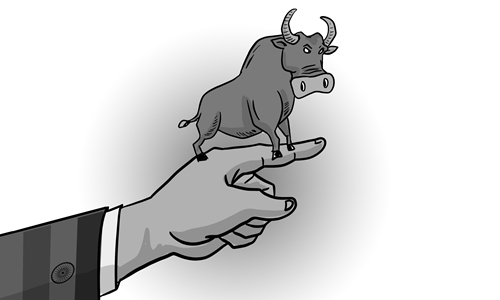HOME >> BUSINESS
How do Chinese and Indian stock markets compare?
By Dong Dengxin Source:Global Times Published: 2019/11/27 20:13:40

Illustration: Luo Xuan/GT
The Indian stock market is older than China's and is more inclusive, market-oriented and internationalized. However, it took China just three decades to attain the development that the Indian stock market gained over more than a century. As China's stock market continues to expedite its opening-up process, foreign investment institutions are expected to be facilitated further.The Indian stock market is known as the oldest in Asia. The Bombay Stock Exchange (BSE), Asia's first stock exchange, was founded in 1875 in Mumbai. At present, India has two principal national exchanges: the BSE and the National Stock Exchange of India (NSE), established in Mumbai in 1992.
China's stock market started later. The Shanghai Stock Exchange (SSE) was established at the end of 1990, and the Shenzhen Stock Exchange (SZSE) was established half a year later.
India's stock market has two major indexes, the BSE Sensex, an index of 30 well-established companies listed on the BSE, and the Nifty 50, the NSE's flagship index. The Sensex is regarded as the pulse of India's domestic stock markets, as the overall market capitalization of its listed companies accounts for around 45 percent of the total capitalization of all listed companies on the BSE.
The Shanghai Composite Index, the Shenzhen Component Index and the blue-chip CSI300 Index are China's most widely recognized indexes and considered to be the most representative.
Starting from 100 points in 1990, currently, the index is at around 2,900 points, a nearly 30-fold rise in three decades. The Sensex has seen a 15-fold rise since liberalization reform in the early 1990s.
India's stock market is much more inclusive than China's, particularly for smaller companies. A total of around 7,000 companies were listed on the country's two bourses by the end of 2018, including two foreign companies.
China's two exchanges had 3,584 listed companies by the end of 2018. As of January, India's stock market had seen a total capitalization of more than $2 trillion, while China's stock market had approached $6 trillion.
The IPO systems and numbers in China and India are also different. India's stock market abolished its administrative-approval system in 1992.
In 2019, China's Science and Technology Innovation Board - or STAR market - piloted its registration-based IPO.
The de-listing system of India's stock market was borrowed from the US model. It is more market-oriented, with higher levels of both de-listings and listings. In 2018, the BSE saw at least 222 companies de-list, some of which were compulsory withdrawals.
China's stock market is less market-orientated. The debut of registration-based IPOs on the STAR market has had a knock-on effect on the A-share market, and there were nine companies suspended or de-listed from China's stock market this year - a 30-year high which is expected to increase in the future.
The internationalization level of a country's stock market can be observed in two dimensions: market access requirements for international capital and IPO requirements for foreign companies.
Two foreign companies have listed on India's stock market, but China's has none. India was opened to foreign capital earlier, having approved foreign investments in India's stock and bonds markets in 1992.
However, China is expediting its opening-up process. From the Shenzhen-Hong Kong Stock Connect to the Shanghai-London Stock Connect, foreign investment is being increasingly facilitated in China's market.
India's securitization ratio was 76.42 percent in 2018, while China's was 46.48 percent, which shows that India's stock market enjoys a more important status in its national economy than China's does in its own.
It's important for China's A-share market to promote reform, including the establishment of a short mechanism and the promotion of registration-based IPOs.
The author is director of the Financial Securities Institute at Wuhan University of Science and Technology. bizopinion@globaltimes.com.cn
Posted in: INSIDER'S EYE